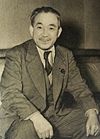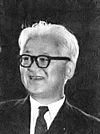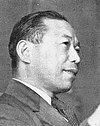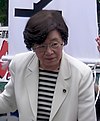Socialist Party of Japan
| Socialist Party of Japan | |||
| Nihon Shakaitō | |||
| Japan Socialist Party | |||
| Parteivorsitz (Chuo shikkōiinkai iinchō) | Murayama Tomiichi | ||
| Deputy Chair |
Satō Kanjū Uehara Kōsuke Chiba Keiko |
||
| Secretary General | Kubo Wataru | ||
| PARC Chair | Sekiyama Nobuyuki | ||
| Parliamentary affairs | Nagai Takanobu | ||
| Group chairmanship in the Sangiin | Aoki Shinji | ||
| founding | November 2, 1945 | ||
| resolution | January 29, 1996 | ||
| Headquarters | 1-8-1 Nagatachō , Chiyoda , Tokyo Prefecture | ||
| MPs in the Shūgiin |
70/511 |
||
| MPs in the Sangiin |
37/252 |
||
| Government grants | 5.62 billion yen (1995) | ||
| International connections | Socialist International | ||
The Socialist Party of Japan ( 日本 社会 党 , Nihon Shakaitō , SPJ) was a political party in Japan that existed from 1945 to 1996. During this time it was mostly the largest opposition party at the national level, from 1947 to 1948 and from 1993 it was part of the government.
history
The SPJ was the first party to be founded in Japan after the Second World War , in 1945. Its first forerunner of the same name dates back to 1906 and was banned as early as 1907. The main founding members had already gained political experience in the 1920s and 1930s, before the military and authoritarian government suppressed wartime activities of the left. However, the Socialist Party was split into different camps from the start: the right wing, with ties to the later Dōmei trade union federation, could have envisaged a coalition with the bourgeois Liberal Party, while the left wing, supported by the Sōhyō trade union federation , preferred to join the Communists would have cooperated. In 1947, for the first and only time, the socialists were able to win the election and appoint the head of government. In less than a year, wing battles, secessionists and, ultimately, a dispute over the budget had wiped out Katayama Tetsu's government .
Foreign policy also led to internal party tensions in setting the course between neutrality and ties to the West. In the dispute over the peace treaty with the United States and the security treaty with the United States , the right and left wing of the party were increasingly opposed to one another. They accused each other of “communist tendencies” or support for “US imperialism”.
As early as the 1950s, the right ( uha ) and left wing ( saha ; in parliament: 第二 十三 控 室 , dai-nijūsan hikaeshitsu , “23rd waiting room”) competed separately in elections. Initially, this was designed as a way to reduce disputes; however, it ultimately weakened the party. In 1955, supporters of both wings agreed on a reunification. In 1960 representatives of the right wing finally left the party and founded the Democratic Socialist Party ( 民主 社会 党 , Minshu Shakaitō , from 1969 民 社 党 , Minshatō , DSP).
Despite the split, the SPJ remained the largest opposition party in Japan until the 1980s. Over time, she gave up some of the more radical positions. The recognition of the existence of the Self-Defense Forces, the recognition of South Korea or the abandonment of the demand for an immediate nuclear phase-out bear witness to this moderation. Together with the popular party chairman Doi Takako , who spoke of internal party perestroika , it led to notable electoral successes in the late 1980s. These were short-lived, however, and ironically, a severe election defeat in 1993 (from 136 to 70 seats) brought the SPJ its second post-war government participation and the overthrow of this first government without LDP participation since 1955 a year later earned it the post of prime minister.
In 1996 the party changed its name to Social Democratic Party ( 民主 社会 党 , Shakai Minshutō , SDP) and lost a large part of the MPs to the forerunners of the later Democratic Party ; It had already changed its English name to the Social Democratic Party of Japan (SDPJ) in 1991 . Five MPs around Yatabe Osamu left the party and founded the New Socialist Party ( Shin-shakaitō ), which retained the traditional core demands of the left wing of the SPJ.
Party leader
| # | Surname | Inauguration | adoption | image |
|---|---|---|---|---|
| 1 | Katayama Tetsu | September 28, 1946 | January 16, 1950 |

|
| - ( right wing ) | Kawakami Jōtaro | January 18, 1953 | October 12, 1955 |

|
| - ( left wing ) | Suzuki Mosaburō | January 19, 1951 | October 12, 1955 |

|
| 2 | Suzuki Mosaburō | October 13, 1955 | March 21, 1960 | |
| 3 | Asanuma Inejirō | March 23, 1960 | October 12, 1960 |

|
| 4 (provisional) | Eda Saburō | October 12, 1960 | March 6, 1961 |

|
| 5 | Kawakami Jōtaro | March 6, 1961 | May 6, 1965 |

|
| 6th | Sasaki Kōzō | March 6, 1961 | May 6, 1965 |

|
| 7th | Katsumata Seiichi | 19th August 1967 | 4th October 1968 | |
| 8th | Narita Tomomi | November 30, 1968 | September 26, 1977 | |
| 9 | Asukata Ichio | December 13, 1977 | September 7, 1983 | |
| 10 | Ishibashi Masashi | September 7, 1983 | September 8, 1986 |

|
| 11 | Doi Takako | September 8, 1986 | July 31, 1991 |

|
| 12 | Tanabe Makoto | July 31, 1991 | January 19, 1993 | |
| 13 | Yamahana Sadao | January 19, 1993 | September 25, 1993 | |
| 14th | Murayama Tomiichi | September 25, 1993 | January 19, 1996 |

|
Government holdings
- 1947–48 46th Cabinet (SPJ, DP , Kokumin Kyōdōtō ) Katayama Tetsu : seven SPJ ministers (including premier)
- 1948 47th Cabinet (SPJ, DP, Kokumin Kyōdōtō) Ashida Hitoshi : eight SPJ ministers (including deputy premier)
- 1993–94 79th Cabinet (SPJ, Shinseitō , Kōmeitō , DSP , NJP , Sakigake , SDF , Minkakuren ) Hosokawa Morihiro : six SPJ ministers
- (In 1994 the SPJ MPs elected the 80th Prime Minister Hata Tsutomu with the other governing parties, but then left the coalition during the formation of the government)
- 1994–1996 81st cabinet including reshuffle ( LDP , SPJ, Sakigake) Murayama Tomiichi : six SPJ ministers (including prime minister)
- 1996 [until renaming] 82nd Cabinet (LDP, SPJ, Sakigake) Hashimoto Ryūtarō : six SPJ ministers
swell
- Manfred Pohl: The political parties in: Country Report Japan , Manfred Pohl / Hans Jürgen Mayer (eds.), BpB 1998, Bonn.
Individual evidence
- ↑ Rina Sanchome: State funding of political parties in Japan. Books on Demand 2004. ISBN 3-8334-0609-7 , p. 90

